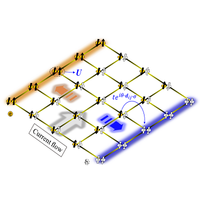Abstract
We investigate an experimental toy-model system of a pseudospin-half square-lattice Hubbard Hamiltonian in to include both nontrivial complex hopping and moderate electron correlation. While the former induces electronic Berry phases as anticipated from the weak-coupling limit, the latter stabilizes an antiferromagnetic Mott insulator ground state analogous to the strong-coupling limit. Their combined results in the real system are found to be an anomalous Hall effect with a nonmonotonic temperature dependence due to the competition of the antiferromagnetic order and charge excitations in the Mott state, and an exceptionally large Ising anisotropy that is captured as a giant magnon gap beyond the superexchange approach. The unusual phenomena highlight the rich interplay of electronic topology and electron correlation in the intermediate-coupling regime that is largely unexplored and challenging in theoretical modeling.
- Received 9 November 2021
- Revised 25 April 2022
- Accepted 2 June 2022
DOI:https://doi.org/10.1103/PhysRevX.12.031015
Published by the American Physical Society under the terms of the Creative Commons Attribution 4.0 International license. Further distribution of this work must maintain attribution to the author(s) and the published article’s title, journal citation, and DOI.
Published by the American Physical Society
Physics Subject Headings (PhySH)
Popular Summary
The strength of the correlation between electrons is often used to categorize quantum materials into three regimes: weak-coupling, strong-coupling, and the intermediate-coupling regime that connects the two limits. In the weak-coupling regime, electrons are free to move individually but are guided by symmetry. In contrast, in the strong-coupling limit, electrons are localized and only temporarily visit neighboring atoms, resulting in magnetic insulators. Such seemingly incompatible outcomes make it interesting but also challenging to understand how the two opposite limits are bridged by the intermediate regime. In this work, we realize a system where hallmarks of both the weak- and strong-coupling regime appear simultaneously, hinting at some of the complex physics that connects them.
We experimentally construct an artificial crystal to purposely remove all rotational symmetries but leave a glide symmetry for electrons with an intermediate coupling strength. The electrons not only form an insulator, as they do in the strong-coupling limit, but also spontaneously break the glide symmetry by ordering their spins magnetically to enable the anomalous Hall effect, a profound example of weak coupling. These behaviors suggest that the characters of the weak- and strong-coupling limits may be blended but in a nontrivial way: Neither the temperature dependence of the anomalous Hall effect nor the magnitude of the symmetry-breaking magnetic anisotropy can be simply understood from the two limits.
This work also demonstrates a controllable material platform for exploring emergent phenomena and rich physics of the intermediate regime by designing and implementing various symmetry configurations in artificial lattice structures.



